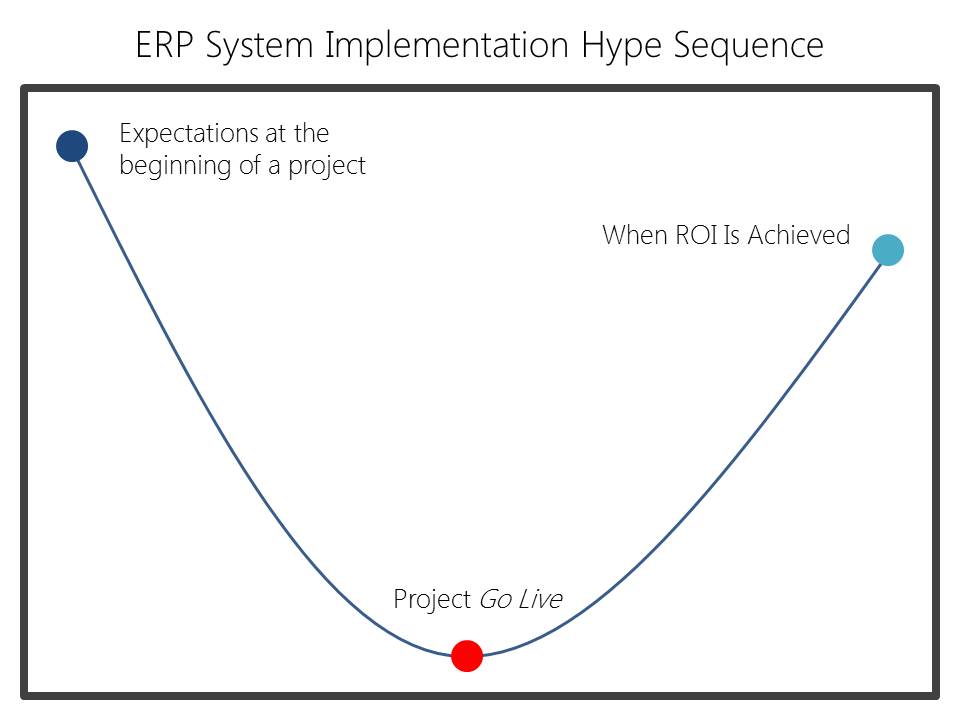An ERP system implementation can be accurately described as a roller coaster of expectations and emotions. In the drawing above, you can see the perceived sentiment of a project when it begins; followed by the wave of changes in perceptions that occur from go live through when companies can expect to achieve ROI. As a top ERP consulting firm for businesses that understand the criticality of an ERP system implementation, we’ve found the above diagram to be surprisingly accurate. Understanding this wave of perceptive changes is paramount to extracting value from your new or proposed system.
The secret to managing a successful ERP system implementation
Businesses often come in to an ERP system implementation project with unrealistic or ill-defined expectations and requirements. This can range from a misguided idea about the need for a new system, to unrealistic goals regarding budget and project schedule.
Many of these front-end project expectation risks can be mitigated by doing simple project due diligence. Comb over online resources to validate preconceived ideas about the premise of the project. If leaders educate themselves around what an initial starting point might look like, they’ll have a better idea of what types of solutions and procedures may lie ahead. This equips the project leaders with the necessary information to properly manage expectations during the early stages of a project.
Key questions that lead to a successful implementation
There are several key elements of a project that leaders should try to understand before setting dates and defining budgets. Here are just a couple vital questions to ask…
- What is the goal of the project? What new business outcomes is the business expecting from this system, and what type of measurable ROI can your organization expect to extract from this project?
- How will users need to interact with the system? What departments will use the system, and how would they like to use it? What are the elements of function that make up the businesses processes that this new system will need to support? Capturing this information is vital to understanding the cost and timeline of the project.
- How will the software work out of the box vs. what needs to be customized? This is something our consultants define clearly for our clients during our proof of concept procedures, and our clients have found it to be extremely helpful. This can help eliminate surprises in costs and schedule.
- What will the roles and responsibilities of the project look like? We’ve covered the importance of roles within a project team before, and even covered who should be on a project team. This is critical to ensuring your organization has the right bandwidth to complete the project successfully.
Riding the wave of excitement vs. go live despair
Typically companies are very excited and motivated to attack a project in the beginning. Software companies are great at selling a future that is robust and ambitious; however the nitty gritty of getting your system to operate within your business the way that you initially imagine can be a real feat. This difficulty often leads many organizations to steer off-course; which affects ROI in the future.
It’s important that project leaders set the right goals up front so that businesses don’t have to begin making schedule and scope changes in the middle of a project. Sometimes this can mean having a certain set of goals that must be completed at go-live, with many of the other elements and modules being implemented later; as a part of continuous improvement. This breaks up the project so that victory (and ROI) is more affordable and achievable.
By the time many businesses go live they’ve bottomed out on expectations. It’s not until 6 months down the road that the organizations are often starting to see significant ROI. This can make these projects extremely taxing, and even this provides a greater incentive to understand what components are most necessary for go live vs. the functions that can be left for a continuous improvement portion of the project.

Artificial timelines can ruin your project’s ROI
One of the biggest mistakes our consultants see businesses make is the declaration of artificial timelines or dates. Every business wants the system to be live so that they can begin extracting value from those expensive licenses; however businesses that rush to implement often experience the greatest cost of failure. Gartner recently published a body of research that suggested that rushing through an ERP system implementation may be the greatest threat to project ROI.
Businesses should understand the project before setting any dates or timelines for completion. If the project appears like it will take much longer than what leaders will accept, organizations should consider how they could break the project up into several smaller projects.
Setting deadlines before the project is scoped and mapped puts unnecessary stress and expectations of stakeholders. This pressure often leads to sub-optimal decision-making. It’s this kind of thinking that can really tank ROI, and lead to a dysfunctional system.
Understanding the project before setting deadlines makes all the sense in the world; however businesses choose to ignore this concept everyday. Many of the projects that we step in to halfway through (to fix) have this issue at the root of their problems.
Wrap-up
Ultimately, businesses that diligently map the project in the beginning will be best equipped to deal with the ebbs and flows of an ERP system implementation. This means understanding project goals, comprehending what realistic expectations are, and fully-grasping what the software can and can’t do prior to creating any deadlines.
Businesses considering a new implementation should read our latest e-book. The information inside of it is essential 101 info on how to extract ROI from a system, and mitigate the most common project risks along the way. if you’d like further help on how your business should approach an upcoming implementation, contact our experts today!



